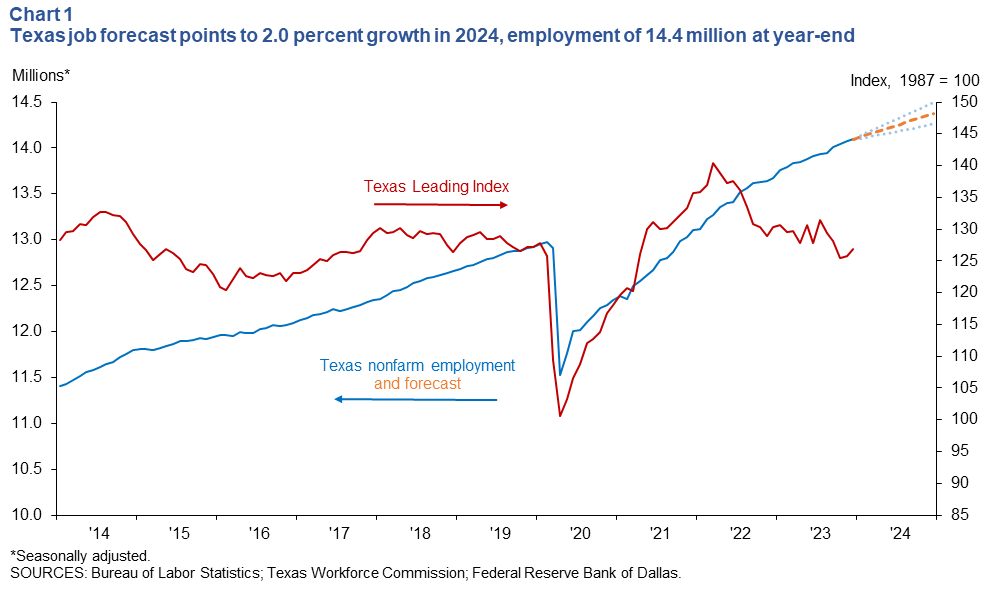Texas Employment Forecast

The Texas Employment Forecast indicates jobs will increase 2.0 percent (283,500 jobs added) in 2024, with an 80 percent confidence band of 1.2 to 2.8 percent. The forecast is based on an average of four models that include projected national GDP, oil futures prices and the Texas and U.S. leading indexes. The forecast suggests that job growth will be in line with the state’s long-term average, and employment in December 2024 will reach 14.4 million (Chart 1).
Texas employment grew 3.1 percent in 2023 after rising 4.3 percent in 2022. The state added over 426,900 jobs last year.
“Texas’ 2023 job growth exceeded expectations, pointing to the resiliency of the labor market,” said Luis Torres, Dallas Fed senior business economist. “Texas ranked fifth among U.S. states in 2023 job growth. Gains were largely broad based across major sectors and the state’s 25 metropolitan areas. High-tech services (Information) was the only sector that recorded job losses in 2023. Robust labor demand pushed up hourly wages, which rose nearly 6 percent last year.”
The Texas Leading Index dipped 0.7 percent over the three months through December 2023 (Chart 2). Half of the index components were negative, including a decline in the real price of West Texas Intermediate oil. The U.S. leading index, the Texas help-wanted index and well permits also dragged on the index. In contrast, increases in the Texas Stock Index and decreases in the Texas value of the dollar and new unemployment claims were positive contributors, while the average weekly hours component was flat and did not contribute to a change in the index.


Next release: March 8, 2024
Methodology
The Dallas Fed’s Texas employment forecast projects job growth for the calendar year and is estimated as the 12-month change in payroll employment from December to December.
The forecast is based on the average of four models. Three models are vector autoregressions where Texas payroll employment is regressed on the lags of West Texas Intermediate (WTI) oil prices, the U.S. leading index and the Texas Leading Index, respectively. The fourth model is an autoregressive distributed lag model with regression of payroll employment on lags of payroll employment, current and lagged values of U.S. GDP growth and WTI oil prices, and Texas COVID-19 hospitalizations through March 2023. Forecasts of Texas payroll employment from this model also use as inputs forecasts of U.S. GDP growth from Blue Chip Economic Indicators and WTI oil price futures. All models include four COVID-19 dummy variables (March–June 2020).
For additional details, see dallasfed.org/research/forecast/.
Contact Information
For more information about the Texas Employment Forecast, contact Luis Torres at luis.torres@dal.frb.org.